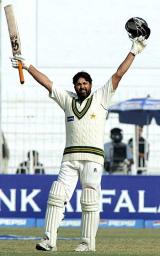Fitting the mantle perfectly
As Pakistani fans celebrate Inzamam's ascent to the pantheon, they are also scanning from horizon to horizon but finding no successor
Saad Shafqat
28-Nov-2005
|
|

|
Privately, Javed Miandad will tell you that he had foreseen Inzamam-ul-Haq as his successor even before the young lad had played a Test match. In March 1992, on a now-famous windswept afternoon at Auckland, Miandad was watching his nation's World Cup hopes disappear when Inzamam walked in and turned the match around. He made 60 from 37 balls, but it wasn't a slog. Even the one truly lofted stroke, a straight lift behind the bowler's head that bounced over the long-off boundary, was described by Richie Benaud as a "lovely, orthodox cricket shot." Standing in the twilight of his career, Miandad was mesmerized at the other end. "All I had to do was keep feeding him the strike," he later said. Someone had finally come along. The mantle had been passed.
Every cricketing nation has its own version of who the country's best batsman might be. (In Australia, of course, the debate is about who the second-best might be.) Brian Lara, Vivian Richards, or Garry Sobers? Sunil Gavasker or Sachin Tendulkar? Aravinda de Silva or Sanath Jayasuria? Martin Crowe or Glenn Turner? The arguments are familiar but rarely tiresome. Statistics lovers will talk about averages, differences, and strike rates. Romantics will wax eloquent about bravery and valor, about character in victory, more so in defeat. And the absolute die-hards will cling to that one unforgettable innings on whose basis all sins must be forgiven.
In Pakistan, as Inzamam took the single to reach his 24th Test hundred, the local version of this debate erupted with new vigor. The natural comparison was to Javed Miandad, although names like Zaheer Abbas and Hanif Mohammad were also bound to come up. As with Miandad before him, history will judge Inzamam against contemporary benchmarks established by a great Indian and a great West Indian. A good case can be made that Inzi has approached Tendulkar and Lara more closely than Miandad did with Gavasker and Richards. Miandad hit a purple patch in his career around the same time - approximately a decade into his Test career - as Inzamam now has, but Inzi has managed to sustain it. Since his triple-hundred against New Zealand at Lahore in 2002, Inzi has made 2355 runs at an exemplary 65.42, including nine centuries and a highest of 329. Over the same period, Lara has scored at 62.95 and Tendulkar at 53.50.
Inzamam also has a great sense of timing, and not just with his square drives. He performs when it matters most, and he makes his performances count. Seventeen of Inzi's 24 centuries have been in a winning cause, a proportion second only to Bradman. Inzamam's performances also lift the batsmen around him. When he goes beyond 30, it is like a rising tide, and Pakistan's average score per batsman jumps up by 10 runs, as pointed out by The Numbers Game. And though it appears unlikely that Inzamam will catch up with his great contemporaries in the number of centuries, he does have more scores of 50+ in international cricket than Brian Lara (156, to Lara's 153). Tendulkar is well ahead on this count at 184.
Meanwhile, as Pakistan's batting records get rewritten, Miandad has come out heartily praising and congratulating Inzamam. We can be assured the sentiments are genuine. In early 2002, when I was interviewing Miandad for his autobiography, he had few positive things to say about the current lot of players, but always stopped short of questioning Inzamam. For his part, Inzamam has widely acknowledged learning the trade from the old Jedi master. The one thing though that he clearly did not pick up from Miandad was running between the wickets. "Forget about the run outs," Miandad said recently. "If Inzi had been properly converting his ones into twos, he'd have well over 10,000 runs by now."
For all of its cricket life, Pakistan has benefited from the services of a batting anchor of great merit. Hanif Mohammad carried on for close to two decades, but when he finally played his last Test match, at Karachi in October 1969, it was also the occasion for Zaheer Abbas's Test debut. When Zaheer's powers began to wane in the early 1980s, Miandad emerged in full bloom. And then in 1992 there was that symbolic partnership in the World Cup semi-final at Auckland. As Pakistani fans celebrate Inzamam's ascent to the pantheon, they are also scanning from horizon to horizon but finding no successor. Ultimately, sport is entertainment, and the greatest measure of a sportsman is when the legions being entertained begin to worry how badly they will miss you when you are gone.
Saad Shafqat co-wrote Javed Miandad's autobiography 'Cutting Edge - My Autobiography'